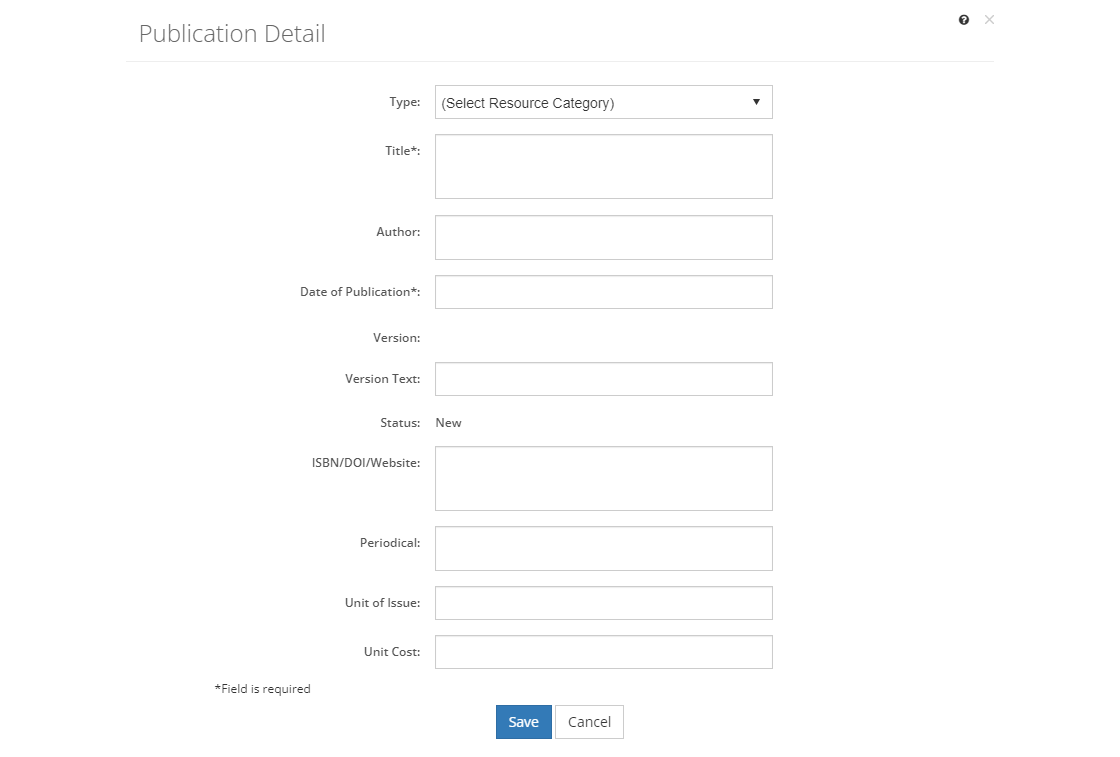•Select ![]() to create a new publication.
to create a new publication.
•Select View  to review a selected publication. If you need to make any changes, select Edit on the Publication Detail screen.
to review a selected publication. If you need to make any changes, select Edit on the Publication Detail screen.
•Select Edit  to make changes to a selected publication.
to make changes to a selected publication.

Figure 341: Publication Detail Screen
Any of these options opens the Publication Detail screen, ready for you to enter, review, or update the fields below. Then:
•To create a new publication, select Save once you've entered all the information. Likewise, to keep the edits you've made to an existing publication, select Save. This will return you to the list of publications.
•If you do not want to keep the edits or create a new publication, just select Cancel to close the pop-up.
•If you're reviewing a publication, you can select Edit to make changes, select Approve to approve the publication, or you can close the pop-up window by selecting the X in the top right of the pop-up.
Publication Fields
Type
The Type or sub-category of the resource. The resource type allows you to further specify what kind of resource it is. You can set up the resource categories on the Customizations screens, to enable you to define groups of resources within the main categories.
Title
The Title or name of the resource. Resources are used or cited extensively in initiatives, specifically, on the following screens:
•Analysis - in the Training Needs Analysis and the Task Analysis.
•Design - in the Training Management Document.
•Develop - in the initiative contents: pages and paragraphs, sheets, and test items.
Author
The Author field contains the author, editor, or organization (if no author is named) of the publication. Typically:
•Single author or editor: Last Name, followed by initials, e.g., Doe, J.
•Multiple authors or editors: last names and initials; commas separate author names, last author is preceded by an ampersand, e.g., Doe J., & Joe, D.
•Organization: Full name of the organization.
Date of Publication
The Date of Publication lists the date or year the publication was published. In the case of websites, or other online resources, this should be the date the publication was accessed.
Version
The Version number of the resource. All resources start with version 1. Once a resource has been approved, changes can no longer be made, unless a new version of the resource is created. Then changes can be made as needed in the new version.
When viewing the resource item, you can view a previous version by selecting it from the Version drop-down.
Status
The current Status of the resource. Once the initiative that uses the resource is approved, then the resource is also approved. You can also approve a resource manually by viewing the resource on the Resources tab and then selecting Approve on the screen. You cannot approve a resource from the Edit screen.
Version Text
The Version Text of the resource. Unlike the Version field, this field is user editable, so you can enter the version number or text of the resource, if applicable.
ISBN/DOI/Website
The ISBN/DOI Website field provides the space needed to capture the:
•International Standard Book Number (ISBN) of a published book, which is typically 10 or 13 digits long
•Digital Object Identifier (DOI) of a journal article (or other registered digital content) that provides a persistent link to its location on the internet
•Website or other location (e.g., intranet location or local server) where the publication can be found
Note: If you include "http://" or "https://" with the website address, then you will get a clickable hyperlink in the various PDF outputs.
Periodical
The Periodical provides the name of the periodical, journal, newspaper, or website of the publication, if applicable.
The Keywords that describe the resource. This information is used when you search for a resource using the Find field.
Unit of Issue
The Unit of Issue indicates how many items of the resource come together in a box or a pack. This helps determine how many resources need to be bought.
Unit Cost
The Unit Cost is the cost of buying one unit (e.g., one box of pencils, or a pack of paper) of the resource.